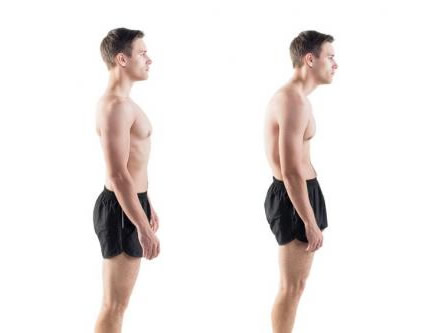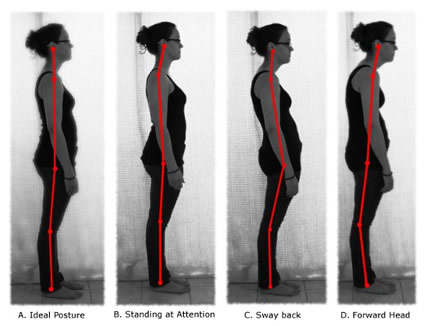The Myth of Bad Posture and Misconceptions About ‘Correction’
By Marco Torres
“Sit up straight son,” said practically every parent around the world at some point. It’s been drilled into us that bad posture will be the source of great pain and discomfort in the future if not corrected. But what if there is no bad posture? What if our posture is a reflection of who we are and changing it has nothing to with either a rudimentary adjustment of joints and muscles or mental focus on obtaining that perfect plumb line. Many postural correction inventions and therapeutic manipulations will have you believe that there is a perfect posture to be attained. Let me explain why bad posture is a myth.
Chiropractors can do some wonderful things for their patients, and there should only be admiration for their skills in treating a wealth of dysfunction in modern populations. However, a good percentage of their treatment protocols center around posture–and that requires a commitment on behalf of their patients which many are not prepared for.
At least chiropractors will follow the route of prevention and apply sensible therapeutic techniques, including exercise programs to help their patients. On the other hand Physicians have gone to more drastic lengths such as bracing, taping and even strapping down body parts to get their victims (I mean patients) into the positions they feel are ideal in what they assume will prevent dysfunction.
Widget not in any sidebars

What Is Dysfunction?
Dysfunction is defined as: an abnormality or impairment in the function of a specified bodily organ or system. In other words, it is what we perceive as not being normal. But ultimately, it is what we say it is. It changes from decade to decade and century to century. What is dysfunctional today, may not be in the near future.
All dysfunction relating to posture relates to our movement and mindset. There is no element of postural dysfunction that occurs in the human body without causation relating to how we move and what we think and feel. The latter is far more significant because what we think and feel makes us move. More on this later (see myth 8), but first an explanation on how posture advice has created distortions on what we perceive is functional when in fact is biomechanically dysfunctional.
8 Myths To Unlearn About Posture
MYTH 1- TUCKING YOU BUTT
By tucking your butt, you miss having the foundational support of a fully extended spine. Tucking your butt takes your leg bones out from under you because your legs should be like vertical posts to properly support your weight. Otherwise, the muscles in your back, shoulders and/or neck must work harder.
MYTH 2 – MAKE EFFORT TO MAINTAIN GOOD POSTURE
Most people feel tired after only a few minutes of assuming what they think is a good posture, and then conclude they must increase their endurance at holding the position. The solution is usually not to increase your ability to sustain effort, but to find a posture that requires less effort. In fact, the sense of effort associated with movement is a good way to determine whether the movement is right for you. In regard to posture, this means your optimal posture should feel easier, not harder, than your current posture.
MYTH 3- HOLDING YOUR CHEST HIGH
Many people think the proper stance is to squeeze back the shoulder blades, angling the breast bone (sternum) slightly up and toward the sky. But this displaces the rib cage, tightens neck muscles, compresses the spine and works many muscles — when the goal is to keep them tension-free. A need to stretch is an indication of stored-up tension caused by unnatural posture–a body in correct alignment has no tight muscles that need relief!
MYTH 4- STRAIGHT AND SYMMETRICAL IS BETTER
It is a bad idea to place too much emphasis on how your posture looks. More important is how it feels and what it can help you do. The visual emphasis on posture probably results from spending too much time looking at pictures of platonically ideal posture shown in books. Every person has a unique bone structure and therefore each person has a unique ideal posture. We all have at least some minor asymmetries in the bones from left to right. Such forces are bound to be different from side to side and therefore asymmetries are the rule not the exception.
MYTH 5- SUCK IN YOUR BELLY
Tensing the belly tightens the diaphragm, putting pressure on the lungs and making it harder to breathe fully — plus it triggers the motion of tilting and tucking the pelvis toward the back, flattening your bottom. This tilted pelvis shifts the pelvic floor muscles out of  place, making it harder for them to support the organs in the lower abdomen and putting excessive tension in the lower back. Also, a tight belly interferes with the work of certain muscle groups — the oblique and transversus abdominis. These are the deepest abdominal muscles — they wrap around the torso, running from the ribs to the pelvis, and are crucial to proper alignment and supporting the core of the body, Porter explained.
place, making it harder for them to support the organs in the lower abdomen and putting excessive tension in the lower back. Also, a tight belly interferes with the work of certain muscle groups — the oblique and transversus abdominis. These are the deepest abdominal muscles — they wrap around the torso, running from the ribs to the pelvis, and are crucial to proper alignment and supporting the core of the body, Porter explained.
MYTH 6 – BAD POSTURE WILL CAUSE PAIN
Certain positions can cause pain if held for too long but the human body is not meant to be in static positions anyway. To suggest you can cure pain by improving posture is quite misinformed. Although these claims have intuitive appeal, they are lacking any strong evidence in support. If bad posture is a major cause of pain, you would expect to find that people with measurable postural distortions would have more pain than people who do not. But that is not what the preponderance of the studies find. Pain is not cause by bad posture, but by the multitude of variables in muscles and joints that stem from emotional trauma and lack of movement.
MYTH 7 – ANATOMICAL PLUMB LINE IS IDEAL POSTURE
Perhaps if we were robots but we are not. There is far too much diversity in anatomical structure across populations around the world depending on age, climate, work environments, movement, etc, for any type of universally applied method of measuring posture to be accurate. We are all human but we are also all unique. Attempting to place every human being in an ideal postural template is much like trying to walk in everybody’s shoes.
MYTH 8 – POSTURE IS PURELY PHYSICAL
Posture has never been a purely physical problem. The body is extremely literal when it comes to pain. The experiences in your life directly manifest in your body and when you encounter an emotional stress, your body shows you exactly what the problem is. So when we have pain in our back, neck, muscles, joints or any other part of the body, it reflects in our posture as well.
In her book “The Sacred Language of the Human Body,” Mona Delfino describes how each body area has a language as to what the organs do, the muscles, the nerves, etc. When a condition occurs in the body in a localized area, it’s to help us discover what we might need to change in order to keep “homeostasis” in our emotions, mental reasoning, and even spiritual living. They are physical guides within us that show us there is a problem relating to how we feel, not that bad posture is the problem itself.
Researchers around the world are slowly integrating research on how ourenergetic and emotional states cause health and/or disease. How we connect emotionally to our overall wellness and wellbeing may indeed be more relevant than any supplement, food, exercise, medical intervention or health treatment.
Finnish scientists have for the first time mapped areas of the bodyactivated according to each emotion (happiness, sadness, anger, etc). This map was compiled following a study of 700 Finnish, Swedish and Taiwanese volunteers.
Posture Benefits Come From Change Within
We all have our habitual equilibrium states and any change we endure affects that equilibrium. Movement is a wonderful way to effectuate change. Once you begin holding a different perspective on life, you posture will change in everything from walking to sitting and even running.
It is entirely true when it comes to the human body and human movement that if you don’t use it…you will lose it, but to use it, you must have the drive, energy and vitality to assist in that process. You don’t need perfect alignment or positioning at all times to be pain free. And if you have rounded shoulders, a depressed chest or slouch, that’s ok. Focus on who you are and how you feel about yourself and the rest will follow.
Sources:
fitnessmagazine.com
eatrunrehabilitate.com
prevention.com
bettermovement.org
This post appeared first at Prevent Disease – Like on Facebook




